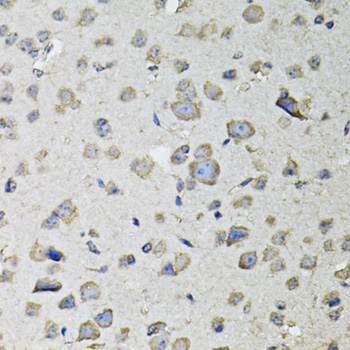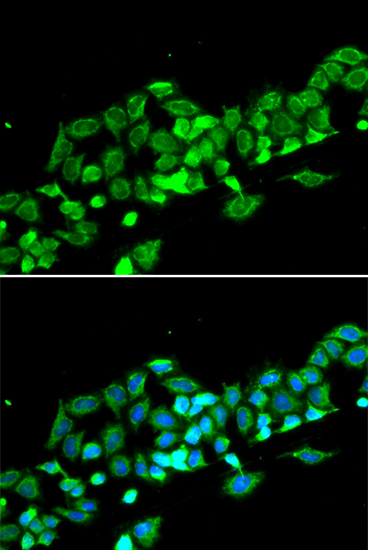Cell Cycle Antibodies 1
Anti-RASSF1 Antibody (CAB12567)
- SKU:
- CAB12567
- Product Type:
- Antibody
- Reactivity:
- Human
- Reactivity:
- Mouse
- Host Species:
- Rabbit
- Isotype:
- IgG
- Antibody Type:
- Polyclonal Antibody
- Research Area:
- Cell Cycle
Description
| Antibody Name: | Anti-RASSF1 Antibody |
| Antibody SKU: | CAB12567 |
| Antibody Size: | 20uL, 50uL, 100uL |
| Application: | IHC IF |
| Reactivity: | Human, Mouse |
| Host Species: | Rabbit |
| Immunogen: | Recombinant fusion protein containing a sequence corresponding to amino acids 101-340 of human RASSF1 (NP_009113.3). |
| Application: | IHC IF |
| Recommended Dilution: | IHC 1:50 - 1:100 IF 1:50 - 1:100 |
| Reactivity: | Human, Mouse |
| Positive Samples: |
| Immunogen: | Recombinant fusion protein containing a sequence corresponding to amino acids 101-340 of human RASSF1 (NP_009113.3). |
| Purification Method: | Affinity purification |
| Storage Buffer: | Store at -20'C. Avoid freeze / thaw cycles. Buffer: PBS with 0.02% sodium azide, 50% glycerol, pH7.3. |
| Isotype: | IgG |
| Sequence: | CCGP RDLG WEPA VERD TNVD EPVE WETP DLSQ AEIE QKIK EYNA QINS NLFM SLNK DGSY TGFI KVQL KLVR PVSV PSSK KPPS LQDA RRGP GRGT SVRR RTSF YLPK DAVK HLHV LSRT RARE VIEA LLRK FLVV DDPR KFAL FERA ERHG QVYL RKLL DDEQ PLRL RLLA GPSD KALS FVLK ENDS GEVN WDAF SMPE LHNF LRIL QREE EEHL RQIL QKYS YCRQ KIQE ALHA CPLG |
| Gene ID: | 11186 |
| Uniprot: | Q9NS23 |
| Cellular Location: | Cytoplasm, Nucleus, Nucleus, centrosome, cytoskeleton, microtubule organizing center, spindle, spindle pole |
| Calculated MW: | 8kDa/9kDa/16kDa/21kDa/31kDa/38kDa/39kDa |
| Observed MW: |
| Synonyms: | RASSF1, 123F2, NORE2A, RASSF1A, RDA32, REH3P21 |
| Background: | This gene encodes a protein similar to the RAS effector proteins. Loss or altered expression of this gene has been associated with the pathogenesis of a variety of cancers, which suggests the tumor suppressor function of this gene. The inactivation of this gene was found to be correlated with the hypermethylation of its CpG-island promoter region. The encoded protein was found to interact with DNA repair protein XPA. The protein was also shown to inhibit the accumulation of cyclin D1, and thus induce cell cycle arrest. Several alternatively spliced transcript variants of this gene encoding distinct isoforms have been reported. |
| UniProt Protein Function: | RASSF1: Potential tumor suppressor. Required for death receptor- dependent apoptosis. Mediates activation of STK3/MST2 and STK4/MST1 during Fas-induced apoptosis by preventing their dephosphorylation. When associated with MOAP1, promotes BAX conformational change and translocation to mitochondrial membranes in response to TNF and TNFSF10 stimulation. Isoform A interacts with CDC20, an activator of the anaphase-promoting complex, APC, resulting in the inhibition of APC activity and mitotic progression. Inhibits proliferation by negatively regulating cell cycle progression at the level of G1/S-phase transition by regulating accumulation of cyclin D1 protein. Isoform C has been shown not to perform these roles, no function has been identified for this isoform. Isoform A disrupts interactions among MDM2, DAXX and USP7, thus contributing to the efficient activation of TP53 by promoting MDM2 self-ubiquitination in cell-cycle checkpoint control in response to DNA damage. Interacts with MAP1S and XPA. Binds to the N-terminal of CDC20 during prometaphase. Binds to STK3/MST2 and STK4/MST1. Isoform A interacts with MOAP1 and E4F1. Recruited to the TNFRSF1A and TNFRSF10A complexes in response to their respective cognate ligand, after internalization. Can self-associate. Isoform A interacts with RSSF5 and probably associates with HRAS1 via a RSSF1 isoform A-RSSF5 heterodimer. Part of a complex with MDM2, DAXX, RASSF1 and USP7. Isoform A interacts (via C-terminus) with DAXX (via N-terminus); the interaction is independent of MDM2 and TP53. Isoform C or isoform H interacts (via N-terminus) with DAXX. Isoform A interacts (via N-terminus) with MDM2 (via C-terminus); the interaction is independent of TP53. Isoform A and isoform C are ubiquitously expressed in all tissues tested, however isoform A is absent in many corresponding cancer cell lines. Isoform B is mainly expressed in hematopoietic cells. 8 isoforms of the human protein are produced by alternative promoter. |
| UniProt Protein Details: | Protein type:Tumor suppressor Chromosomal Location of Human Ortholog: 3p21.3 Cellular Component: cytoplasm; microtubule cytoskeleton; nucleus; plasma membrane Molecular Function:protein binding; zinc ion binding Biological Process: cell cycle arrest; Ras protein signal transduction Disease: Lung Cancer |
| NCBI Summary: | This gene encodes a protein similar to the RAS effector proteins. Loss or altered expression of this gene has been associated with the pathogenesis of a variety of cancers, which suggests the tumor suppressor function of this gene. The inactivation of this gene was found to be correlated with the hypermethylation of its CpG-island promoter region. The encoded protein was found to interact with DNA repair protein XPA. The protein was also shown to inhibit the accumulation of cyclin D1, and thus induce cell cycle arrest. Several alternatively spliced transcript variants of this gene encoding distinct isoforms have been reported. [provided by RefSeq, May 2011] |
| UniProt Code: | Q9NS23 |
| NCBI GenInfo Identifier: | 50401686 |
| NCBI Gene ID: | 11186 |
| NCBI Accession: | Q9NS23.1 |
| UniProt Secondary Accession: | Q9NS23,O14571, O60539, O60710, Q0VGC6, Q5TZT2, Q9HB04 Q9HB18, Q9NS22, Q9UND4, Q9UND5, B7ZLL1, |
| UniProt Related Accession: | Q9NS23 |
| Molecular Weight: | 8,656 Da |
| NCBI Full Name: | Ras association domain-containing protein 1 |
| NCBI Synonym Full Names: | Ras association domain family member 1 |
| NCBI Official Symbol: | RASSF1 |
| NCBI Official Synonym Symbols: | 123F2; RDA32; NORE2A; RASSF1A; REH3P21 |
| NCBI Protein Information: | ras association domain-containing protein 1 |
| UniProt Protein Name: | Ras association domain-containing protein 1 |
| Protein Family: | Ras association domain-containing protein |
| UniProt Gene Name: | RASSF1 |
| UniProt Entry Name: | RASF1_HUMAN |
View AllClose






![RASSF1A Monoclonal Antibody [P3F3AT] (CPAB0547) RASSF1A Monoclonal Antibody [P3F3AT] (CPAB0547)](https://cdn11.bigcommerce.com/s-rd6ounxcu2/images/stencil/590x590/products/58768/63950/rassf1a-monoclonal-antibody-p3f3at-cpab0547__99090__95623.1706535211.jpg?c=1)


